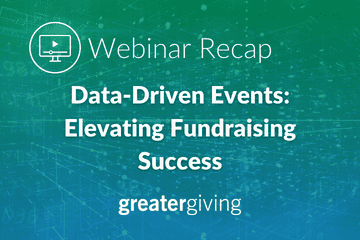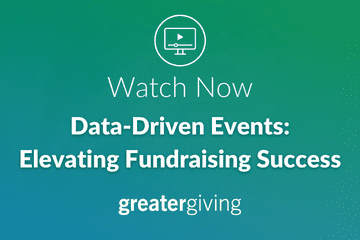
Fundraising Data: The Secret Weapon for Event Success
During the Greater Giving hosted webinar Data-Driven Events: Elevating Fundraising Success, Stephen Kilbreath and Julianne Read of Kilbreath Events discussed the power of data-driven fundraising. Stephen Kilbreath and Julianne Read have been working in fundraising events since the 1990s, and bring an incredible amount of experience to the table.
Donors are being more picky about what they’re attending and why, which makes their experience at your event even more important. Fundraising Data tells us that baby boomers and Gen X donors are accustomed to standard, longer events with socializing and sit-down dinners—whereas millennials and Gen Z donors often want to make their donation and then get on with their day.
So how do you create a donor experience that brings your attendees back year after year? An event that caters to their wants and needs? The key to a successful fundraising event is creating a memorable experience for donors. This means selecting those activities at the event that donors enjoy most and getting rid of whatever isn’t working for them.
Creating a Strategic Event Plan
A great event strategy is one that incorporates insights learned from your historical fundraising data. It provides what donors find exciting about your event, keeping them engaged in fundraising throughout the night.
Pull Previous Years’ Reports
The first step is to create a simple year-over-year dashboard from your fundraising data. You can accomplish this by pulling reports from your previous events.
Here is some of the most important data to grab from past years:
- Package and sales data, organized by section
- Admissions data and sponsorship data
- Live auction sales
- Fund-a-need/paddle raise data
- Performance of revenue enhancers
Analyze Fundraising Data
When you’re ready to compile and analyze your fundraising data, set aside your other projects. This is important and will require your focus!
Get curious! Ask lots of questions of your data to get answers that will help you. Why does the data look this way?
If you’ve seen a drop in ticket sales, ask yourself why. Are you tailoring your event to your specific audience?
If you’ve seen sponsorships go down one year and then up the next year, what did you do that worked? Who was soliciting during those years?
What was your ROI on your live auction items? Is your silent auction revenue rising or decreasing?
What about donor surveys? Julianne tells us there’s a way to get feedback from donors without sending a survey. Try talking to your most engaged donors one-on-one to find out what they liked best about the event. This is a great opportunity to connect with them without asking for money.
Reviewing Current Trends
Keep yourself up to date with industry publications, newsletters, and seminars.
Maintain a network of peers who can provide information about what’s working for them and what isn’t anymore.
You might be surprised to find that what stands out to donors isn’t always a game or revenue enhancer. Often what improves a donor’s experience is a smooth check-in line, a meaningful mission, or socializing with their friends.
Use Your Fundraising Data to Build a Plan
Once you have fundraising data about what worked with donors at your event and what didn’t, you can refresh your event with the elements that are working, and shed anything that isn’t paying off.
Are raffle sales down? Consider changing up your raffle strategy. Perhaps you have too many raffles, your tickets aren’t priced correctly, or your prizes aren’t alluring enough.
If your dessert dash is working, keep doing it!
If attendance has dropped between years, you might need to change up the format of your event to suit your audience.
Getting Leadership On Board
If your board is intent on continuing the same event as before, you’ll need to convince them with your new strategy.
Rather than presenting your plan to them all at once, try socializing with them individually to see how they respond to your fundraising data and the conclusions you’ve drawn. Take their insight into account when you communicate your plan!
You can also talk to your bigger, more engaged donors to get their feedback on what you’ve learned, and get their opinion on your new approach.
A Data-Driven Approach to fundraising Success 
Remember, data is not just about the numbers; it’s about understanding your donors and their needs. Start your data-driven journey today. Analyze your past events, listen to your donors, and stay informed about industry trends. With a strategic and data-backed approach, your fundraising events will not only be impactful but also leave a lasting impression on your donors, fostering long term support for your mission.
